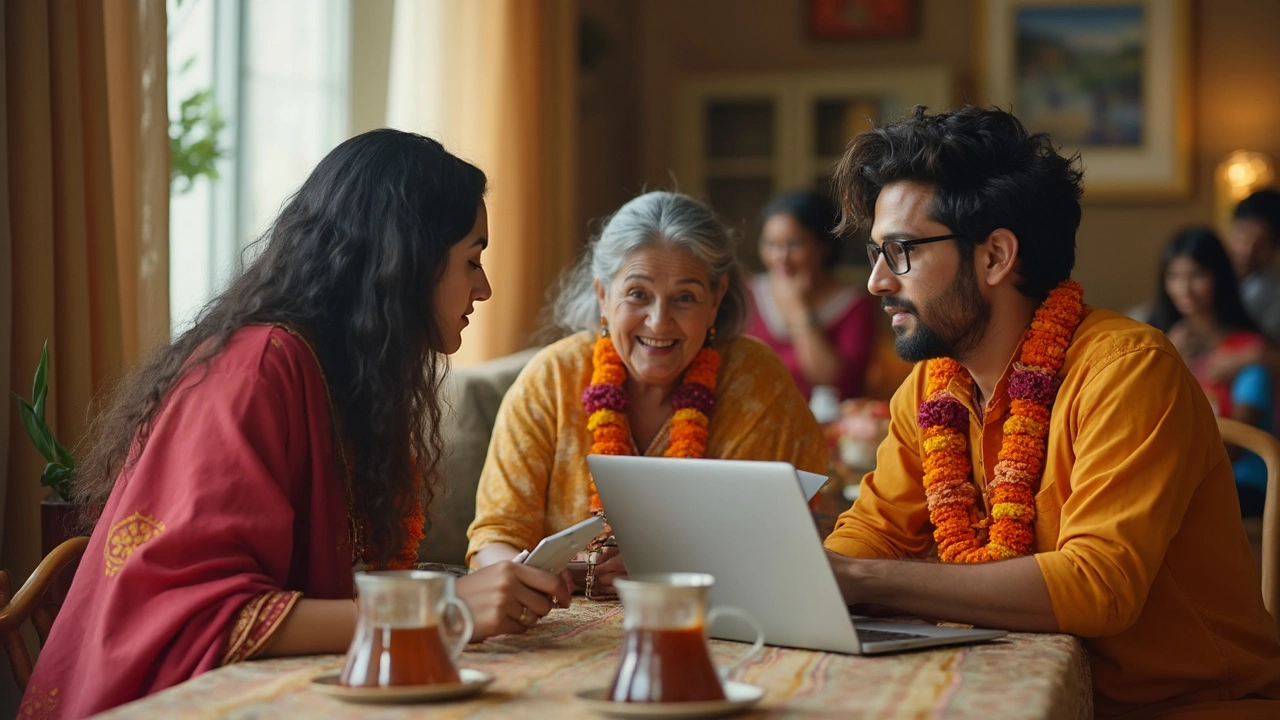If you think planning a wedding in India is a big deal, just wait till honeymoon expenses pop up. Who pays for the dream vacation? Turns out, this answer isn't as straightforward as folks imagine. The money talk gets even trickier when families are involved and expectations run high.
In the old days, it was almost always the groom's side handling honeymoon costs. But fast-forward to 2025, and couples are way more involved in making (and paying for) their own plans. Plenty of brides and grooms now split costs, or take charge themselves to avoid family drama. Still, there's a ton of variety—no two weddings do things exactly the same way.
If you're about to get married or just curious about what really goes on, knowing who usually pays—and how to navigate money conversations—can save a ton of stress. The good news? With a little prep, you can skip awkward talks and get to the fun part: planning where to go without worrying who’s picking up the tab.
- Where Did the Tradition Start?
- Who Traditionally Pays—Bride or Groom?
- How Modern Couples Are Flipping the Script
- Common Arrangements and What Actually Happens
- Smart Tips for Splitting Honeymoon Costs
Where Did the Tradition Start?
The idea of a honeymoon didn't even exist in traditional Indian culture until the last century. Back then, right after the wedding, couples usually lived with family—honeymoons were not on anyone’s radar. Things changed in the mid-20th century when travel and privacy slowly became priorities, especially among urban families. The honeymoon trend started in big cities like Mumbai and Delhi and was inspired by what people saw in Western movies and Bollywood.
At first, honeymoons were rare and were mostly for the well-off. Only in the last 30-40 years did taking a honeymoon become common for Indian couples, even among middle-class families. The whole idea was about giving newlyweds a private break after weeks of chaotic wedding events. Paying for it? That only got more attention as honeymoons went from “maybe” to “must have.”
Traditionally, once families started budgeting for honeymoons, it was usually the groom’s parents who covered the costs—treating it as another wedding expense. This made sense at a time when the groom’s side typically handled most of the post-wedding stuff, including a new home set-up. Over time, with more couples earning and planning their own trips, who pays has become way less predictable.
| Year/Period | Who typically paid? | Why? |
|---|---|---|
| Before 1970s | No tradition of honeymoons | Couples lived with extended family, privacy not prioritized |
| 1980s–1990s | Mostly groom’s family | Seen as extension of wedding expenses, social expectation |
| 2000s–Present | Varies: groom’s family, split, or couple themselves | Modern values, joint earning, personal choices |
One thing that hasn’t changed? People still ask, “Who pays for honeymoon in India?” because the answer is different for every family. That keeps this topic a hot one at every wedding discussion table.
Who Traditionally Pays—Bride or Groom?
Ask most people in India, and you’ll hear the groom’s family usually foots the bill for the honeymoon. This is tied back to old customs where the groom’s side took care of most wedding post-ceremonies—honeymoon included. This practice got passed down as an unwritten rule, especially in North India and among traditional families.
Back in the day, it was a simple setup: the bride’s family took care of the wedding and big receptions, while the groom’s family rewarded the newlyweds with a honeymoon trip. It was often seen as a gift or a symbolic gesture to mark the couple’s fresh start together.
- In most Hindu and Sikh weddings, the groom’s side handled honeymoon bookings, travel, and hotel stays—sometimes without much say from the couple themselves.
- States like Punjab, Rajasthan, and Uttar Pradesh leaned hard on this system, though coastal regions sometimes did things differently.
- The honeymoon wasn’t just a quick trip; sometimes, it turned into a fully hosted tour covering major sights for over a week.
Even a decade ago, surveys showed that nearly 75% of urban North Indian weddings had the groom’s family paying for the couple’s first trip together. Here’s a look at average expenses by region, based on wedding planners interviewed last year:
| Region | Who Pays (Traditionally) | Average Honeymoon Spend (2024, INR) |
|---|---|---|
| North India | Groom’s family | 2-4 lakhs |
| West India | Groom’s family | 2-3 lakhs |
| South India | Mixed/shared | 1.5-2.5 lakhs |
| East India | Shared/varies | 1-2 lakhs |
Girls’ families sometimes chipped in, but it was more out of courtesy than tradition. Still, the most important honeymoon expenses India tradition stuck for generations: groom’s side, groom’s tab. If families could afford a splashy trip to Bali or Paris, it was a way to show status; if not, a local getaway still worked.
Of course, all this is changing fast, but knowing where these habits started helps to understand why money talk still gets sensitive when honeymoons come up.

How Modern Couples Are Flipping the Script
Traditional expectations around honeymoon expenses India have shifted, and the new generation is making their own rules. Instead of waiting for families to decide, most urban couples in their late 20s and early 30s now sit down together to discuss and plan their getaway. In a 2023 survey by a popular Indian wedding platform, over 60% of newlyweds said they funded their own honeymoon, either together or by splitting bills based on income.
It doesn't stop at who pays. Many couples want full control over destination, budget, and itinerary. Instead of formal family discussions, they pick places off the beaten path—like Bali, Greece, or even a simple road trip across Uttarakhand—without worrying about what the elders expect.
Here’s how couples usually handle it now:
- They set a honeymoon budget together, based on what they actually want, not what family can afford.
- Some divide costs 50/50, while others split based on earnings—if one earns more, they might pay a bit extra.
- Many choose to handle everything discreetly, so it doesn’t become a topic of gossip among relatives.
- It’s pretty common to use honeymoon funds, digital wallets, or even wedding gifts to cover part of the bill.
One thing hasn’t changed—everyone still loves a great deal. Couples keep an eye on travel discounts, use airline miles, and do a lot of research before booking anything. If you’re planning your own trip, this approach gives you more options, less stress, and lets you create memories your way.
Common Arrangements and What Actually Happens
Let’s cut straight to it: in most Indian weddings today, there’s no single rule about who picks up the honeymoon expenses India. How things pan out depends on the families, where they live, and how modern the couple is in their thinking. Some folks stick to old ways, but a lot are ditching those for what works best for everyone involved.
Here’s what actually goes on when it’s time to pay for the honeymoon:
- Groom’s Side Pays: Still common, especially in North India. The groom’s family sees the honeymoon as part of their wedding tab. Sometimes, they even treat it as a “gift” to the couple—usually planned and booked by the groom’s parents.
- Bride’s Side Chips In: Not very traditional but does happen in some families who want equal involvement. It’s rare, and if it happens, the bride’s parents may offer a specific cash gift earmarked for travel.
- Couple Splits Costs: More and more popular in cities like Mumbai, Bangalore, and Delhi. When both are working, they just pool savings or pay by themselves. This is a good way to avoid family fights and keep things simple.
- Honeymoon as a Wedding Gift: There are plenty of stories about friends and cousins chipping in for the honeymoon as a group present. Most common among close-knit friend groups who want to do something special.
To help you get a sense of what’s most usual, check out real-life numbers below based on a 2024 Reddit survey from r/IndiansWedding:
| Arrangement | Percent of Couples |
|---|---|
| Groom’s side pays | 39% |
| Couple splits costs | 48% |
| Bride’s side pays | 6% |
| Friends gift honeymoon | 7% |
So, splitting costs is clearly taking the lead, especially among couples living in bigger cities or with more progressive families. But remember: rural places or smaller towns still hold on to older traditions, so the groom’s family footing the bill is still alive and well there.
Whatever you decide, it helps to talk early and get everyone on the same page. Nothing kills the vibe like a last-minute argument over flight bookings or resort upgrades. Couples often say sorting out the money part ahead of time saved them a ton of stress down the line.

Smart Tips for Splitting Honeymoon Costs
Tackling honeymoon expenses can get awkward, especially with the mix of old traditions and modern expectations in Indian weddings. The most important thing? Be honest and plan early. Couples who talk about money before booking anything dodge way more problems later.
Here are some practical ways to handle it:
- Start the money conversation early. Don’t wait until flight prices shoot up or hotels run out. Just sit together, lay out what you both want, and talk numbers. If your families are helping, loop them in sooner rather than later.
- Set a clear budget. Agree on a total spend, then break it down: flights, hotels, food, sightseeing. Apps like Splitwise or Google Sheets make it super easy to track each cost.
- Decide on the split. Going 50-50 is common today, but don’t feel pressured. Some couples split by percentage, especially if one can pay more. There’s no rule—just make sure it feels fair to both.
- Book things together. Whether it’s airline tickets or the resort, book using one account then settle up. That way, nothing gets missed and both are equally involved.
- Watch out for hidden costs. Pocket money, meals outside the hotel, or travel insurance can add up. List these out so there are no ugly surprises.
And if parents want to chip in? Be clear about what they’re giving, and what’s on you. It cuts the confusion. Couples often share expenses now, especially when planning their own trip. It’s not just about following tradition; it’s about starting your married life with some teamwork.
So, if you’re looking up honeymoon expenses India, remember that planning, clear communication, and using tech tools can make things smooth—and maybe even fun.
